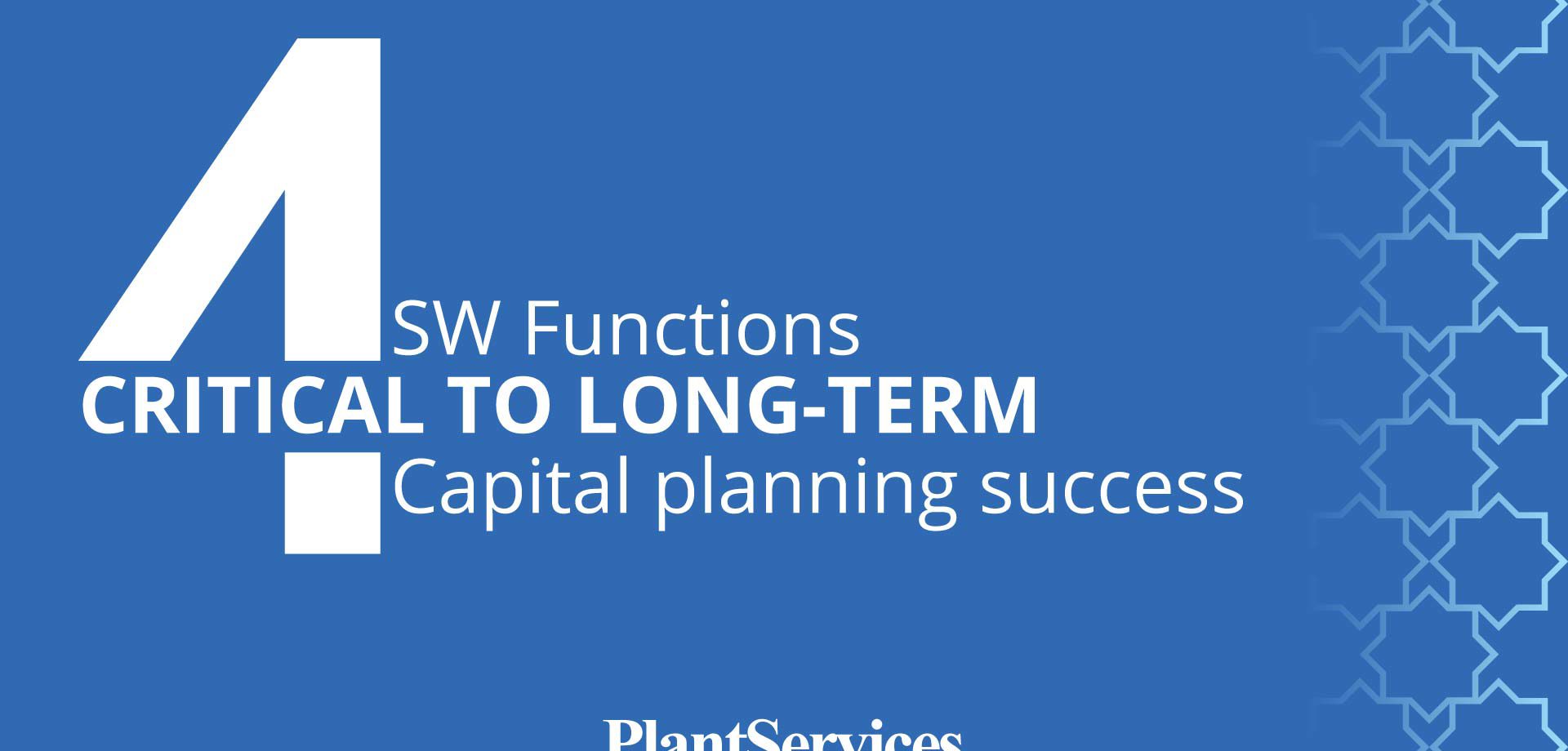By David Berger – plantservices.com
No one likes surprises, especially big expensive ones. Senior management is no exception. That is why long-term capital planning is an essential function within any company. Any organization that owns or manages physical assets such as plant equipment, facilities, vehicles, infrastructure, or computer equipment, must be vigilant in anticipating the need for major repairs or replacement.
There are multiple software solutions that can be used to support long-term capital planning. This includes simple spreadsheets, specialized long-term capital planning software packages, a CMMS with some or all of the required functionality, or some combination of these solutions. Regardless of which software solution you choose, they all should adequately support the following functions, as described in this column: (1) building an asset registry, (2) condition monitoring, (3) work execution and documentation, and (4) multi-year analysis and reporting.
1) Building an asset registry
The foundation of any capital planning tool is an inventory of all of your physical assets, including key components, in the form of an asset registry. The asset registry consists of the following:
Asset hierarchy – The asset hierarchy organizes the inventory of assets and components into a logical framework showing parent-child relationships. Some industries have developed standard hierarchies that are widely shared across the supply chain for the industry. For example, the Vehicle Maintenance Reporting Standards (VMRS) codes were established by the American Trucking Association to standardize on the hierarchy of vehicle assets in terms of systems, sub-systems, and components. As well, progress has been made in building a hierarchy of essentially problem / cause / action codes related to the asset hierarchy. Some of the CMMS vendors will sell their software with VMRS codes preloaded, and will allow users to edit the coded fields to better match their specific fleet specifications or to provide greater detail.
Standards for facility assets also provide a similar example. One of the standards is ASTM E1557 UNIFORMAT II published by the American Society for Testing and Materials. It breaks down a facility into standard parent-child relationships, for example, level 1 – building interiors, level 2 – stairs, and level 3 –stair finishes.
Position hierarchy – Whereas the asset hierarchy provides the functional parent-child relationship amongst systems, assets, and their components, a position hierarchy provides the relative or absolute location of the assets. For example, the four wheel assemblies of a vehicle can be described in terms of their position, such as “left front”. The position hierarchy can also be used to denote the physical location of an asset, such as 50 pumps located along a pipeline or within a plant.
Asset master data – The asset registry should provide the ability to enter master data that describes each asset such as serial number, manufacturer, manufacturer product code, date of installation, asset criticality, and other static data. Most CMMS packages also allow users to define asset types and a specification template specific to each asset type. Thus, drywall can be described in terms of sheet length, width, and thickness, as opposed to say, motors that can be described in terms of AC/DC, voltage, amperage, and RPM.
Lifecycle data – Critical to long-term capital planning, lifecycle data should be recorded including information regarding the economic repair and replacement of at least the critical assets and components. For example, when is it most economical for a bus to be overhauled, replaced, or both over its lifetime, and at what anticipated costs? In what years will a given piece of production equipment or its major components likely require significant repair or replacement, and at what cost? The source of this data may be historical records, benchmark studies in the industry, the manufacturer, and/or engineering studies. Note that expected costs must be kept current somehow, through vendor quotations, similar work done recently, or by estimating periodic price adjustments using recognized indices such as the consumer price index (CPI), construction cost index (CCI), and other benchmarks.
2) Condition monitoring
Once the asset registry is built, the next step is to establish the parameters for monitoring the condition of assets, conduct inspections, and document any resultant changes to lifecycle data.
Triggers – For assets that will be monitored as to their condition, determine one or more measures that best indicate asset deterioration and, in turn, predict failure. For example, perhaps vibration indicates the amount of wear associated with a given production tool. For infrastructure such as roads, bridges, and pipelines, the dimensions and growth rate of features (e.g., cracks) are a typical indicator that is monitored. For some assets, indices or a risk score can be established that indicates the overall health of the asset in broader terms of probability and severity of a potential safety, environmental, financial, reputational, or other impact.
Triggers then are established defining what action is required and when. For example, if the risk score is say, 40 or more out of 50, then a certain major component must be replaced. In other cases, upper and lower control limits are established, beyond which indicates the need for action. More sophisticated CMMS packages can also monitor trend lines and patterns that indicate action is required.
Lifecycle plan adjustments – Once inspections are completed, lifecycle data is then updated either automatically (e.g., automated line inspections) or manually (e.g., building inspections by an engineering consultant). Lifecycle data that may require updating includes expected life, work required, and expected cost.
3) Work execution and documentation
It is one thing to plan activities such as a major capital project, but for some companies, it can be far more challenging to fund, execute, or document the work.
Project budgeting – As each year unfolds, the software must accommodate the inevitable changes to budgets and schedules due to unanticipated priority work, unforeseen resource requirements, insufficient funding, and so on.
Work execution – The software should support users in managing the quality, cost, and timing of work done, including functionality such as project management, work order control, scheduling tools, and front-line access to equipment history.
Work documentation – After completing major repairs and replacement work, users must be able to update the software to reflect the actual costs, problem / cause / action codes, unplanned follow-on work required, and other relevant data.
4) Multi-year analysis and reporting
The logical benefit of entering the static, planned, and actual data as outlined above, is that long-term forecasts can be prepared, and historical data analyzed. Some key reports are as follows:
Forecast view – One of the most critical reports for long-term capital planning is a multi-year budget showing the estimated spend each year on major repair/replacement of assets. The software should allow users to easily filter, sort, drill down, graph, and even do what-if analysis on the data, for example, showing anticipated expenditure trends for a given asset, asset type, or repair type over the next 25 years. More sophisticated software will allow users to adjust interest rates, apply aging factors (e.g., excessive usage or harsh environmental conditions), and change other modelling assumptions.
Historic view – Most CMMS packages are excellent for reporting on work history, providing labor, materials, and contractor costs by asset, asset type, problem code, and many other variables, for any user-defined timeframe. The information comes from work orders or projects. Reports can also show all deferred maintenance and capital projects. Additionally, some software applications will allow users to track trends such as the premature deterioration of assets, by comparing the original versus latest estimates of expected useful life or lifecycle cost. The more comprehensive CMMS packages will also record the total lifecycle cost of each asset by accumulating work order cost history, purchase price, and salvage value. This can then be compared across various asset groups.


